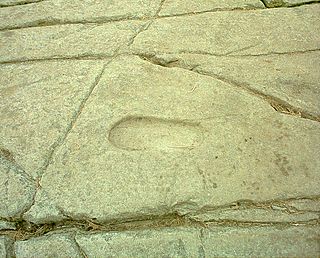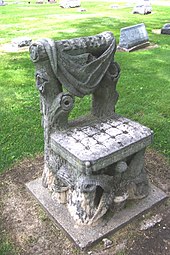
Legend tripping is a name bestowed by folklorists and anthropologists on an adolescent practice in which a usually furtive nocturnal pilgrimage is made to a site which is alleged to have been the scene of some tragic, horrific, and possibly supernatural event or haunting. The practice mostly involves the visiting of sites endemic to locations identified in local urban legends. Legend tripping has been documented most thoroughly to date in the United States.

A headstone, tombstone, or gravestone is a stele or marker, usually stone, that is placed over a grave. It is traditional for burials in the Christian, Jewish, and Muslim religions, among others. In most cases, it has the deceased's name, date of birth, and date of death inscribed on it, along with a personal message, or prayer, but may contain pieces of funerary art, especially details in stone relief. In many parts of Europe, insetting a photograph of the deceased in a frame is very common.

The American Battle Monuments Commission (ABMC) is an independent agency of the United States government that administers, operates, and maintains permanent U.S. military cemeteries, memorials and monuments primarily outside the United States.

Westminster Hall and Burying Ground is a graveyard and former church located at 519 West Fayette Street in Baltimore, Maryland, United States. It occupies the southeast corner of West Fayette and North Greene Street on the west side of downtown Baltimore. It sits across from the Baltimore VA hospital and is the burial site of Edgar Allan Poe (1809–1849). The complex was declared a national historic district in 1974.

Oakland Cemetery is one of the largest cemetery green spaces in Atlanta, Georgia, U.S. Founded as Atlanta Cemetery in 1850 on six acres (2.4 hectares) of land southeast of the city, it was renamed in 1872 to reflect the large number of oak and magnolia trees growing in the area. By that time, the city had grown and the cemetery had enlarged correspondingly to the current 48 acres (190,000 m2). Since then, Atlanta has continued to expand so that the cemetery is now located in the center of the city. Oakland is an excellent example of a Victorian-style cemetery, and reflects the "garden cemetery" movement started and exemplified by Mount Auburn Cemetery in Massachusetts.

An unmarked grave is one that lacks a marker, headstone, or nameplate indicating that a body is buried there. However, in cultures that mark burial sites, the phrase unmarked grave has taken on a metaphorical meaning.

Salem Street Burying Ground is a cemetery located at the intersection of Salem Street and Riverside Avenue in Medford, Massachusetts. The Salem Street Burying Ground was used exclusively from the late 17th century to the late 19th century for the burial of the town's wealthy. The cemetery was listed on the National Register of Historic Places in 1981.

Camp Chase was a military staging and training camp established in Columbus, Ohio in May 1861 after the start of the American Civil War. It also included a large Union-operated prison camp for Confederate prisoners during the American Civil War.

Germoe is a village and civil parish in Cornwall, England, United Kingdom. Germoe village, the parish's main settlement and church town, is about five miles (8 km) west of Helston and seven miles (11.3 km) east of Penzance. The A394 Penzance to Helston road runs along the southern border of the parish. Other settlements in the parish include Balwest, Boscreege and Tresowes Green.

Chippiannock Cemetery is a rural cemetery located on 12th Street and 31st Avenue in Rock Island, Illinois, United States. The word “Chippiannock” is a Native American term which means “place of the dead”. It was listed on the National Register of Historic Places in 1994.

A petrosomatoglyph is a supposed image of parts of a human or animal body in rock. They occur all over the world, often functioning as an important form of symbolism, used in religious and secular ceremonies, such as the crowning of kings. Some are regarded as artefacts linked to saints or culture heroes.

Old Gray Cemetery is the second-oldest cemetery in Knoxville, Tennessee, United States. Established in 1850, the 13.47-acre (5.45 ha) cemetery contains the graves of some of Knoxville's most influential citizens, ranging from politicians and soldiers, to artists and activists. The cemetery is also noted for the Victorian era marble sculpture and elaborate carvings adorning many of the grave markers and headstones. In 1996, the cemetery was added to the National Register of Historic Places.

Oaklawn Cemetery is the first public burial ground in Tampa, Florida, United States. The location was deeded in the mid-19th century and was described as the final resting place for "White and Slave, Rich and Poor." Oaklawn Cemetery is located at the intersection of Morgan Street and Harrison Street in downtown Tampa, about two blocks South of I-275. It has approximately 1,700 graves.
The following are reportedly haunted locations in Pennsylvania:

Crystal Valley Cemetery is a cemetery located on Plainview Place in Manitou Springs, Colorado. Since its establishment in 1882, it has been the principal cemetery in Manitou Springs. It is listed in the National Register of Historic Places.

Old Live Oak Cemetery is a historic cemetery in Selma, Alabama founded in 1829 and expanded in 1877. The newer portion is sometimes called New Live Oak Cemetery and the cemetery is collectively known as Live Oak Cemetery. It contains burials of Confederate States of America leaders, as well Benjamin Sterling Turner, a formerly enslaved African-American who served as U.S. Representative for Alabama during the Reconstruction era. The cemetery is at 110 Dallas Avenue approximately 0.7 miles (1.1 km) west of downtown Selma.

The Hi Jolly Monument is a grave site in the Hi Jolly Cemetery located at Quartzsite, Arizona, United States, marking the grave of Hi Jolly, a Syrian-born camel driver brought to the United States in 1856 to drive camels for the US Cavalry. The site is located halfway between Phoenix, Arizona, and Los Angeles, California. It was added to the National Register of Historic Places in 2011.

Lafayette Cemetery was a cemetery in the Passyunk Square neighborhood of Philadelphia, Pennsylvania. It was established in 1828 and originally intended for 14,000 burials but over time fell into disrepair and became overcrowded with 47,000 burials. In 1946, the cemetery was condemned by the city of Philadelphia. The bodies were disinterred in 1947, transported to the Evergreen Memorial Park in Bensalem, Pennsylvania, and reinterred in a mass grave.


















